Professional Skills: Case Study of Servant Leadership in Sales
VerifiedAdded on 2020/01/23
|9
|2385
|154
Case Study
AI Summary
This case study examines professional skills within a sales environment, identifying conflicts between employees and decreased work efficiency due to stress. It delves into the causes of these issues, such as jealousy, personal grudges, and work-related stress, proposing solutions like stress management activities, time management training, and the implementation of business etiquette. The study also outlines a social event employee behavior policy, discussing acceptable and unacceptable behaviors, and provides an overview of servant leadership, highlighting its benefits such as improved workplace diversity, increased productivity, and enhanced employee loyalty. The report emphasizes the importance of servant leadership in fostering a positive work environment and resolving conflicts, leading to long-term organizational success.

PROFESSIONAL
SKILLS, PORTFOLIO,
CASE STUDY
SKILLS, PORTFOLIO,
CASE STUDY
Paraphrase This Document
Need a fresh take? Get an instant paraphrase of this document with our AI Paraphraser
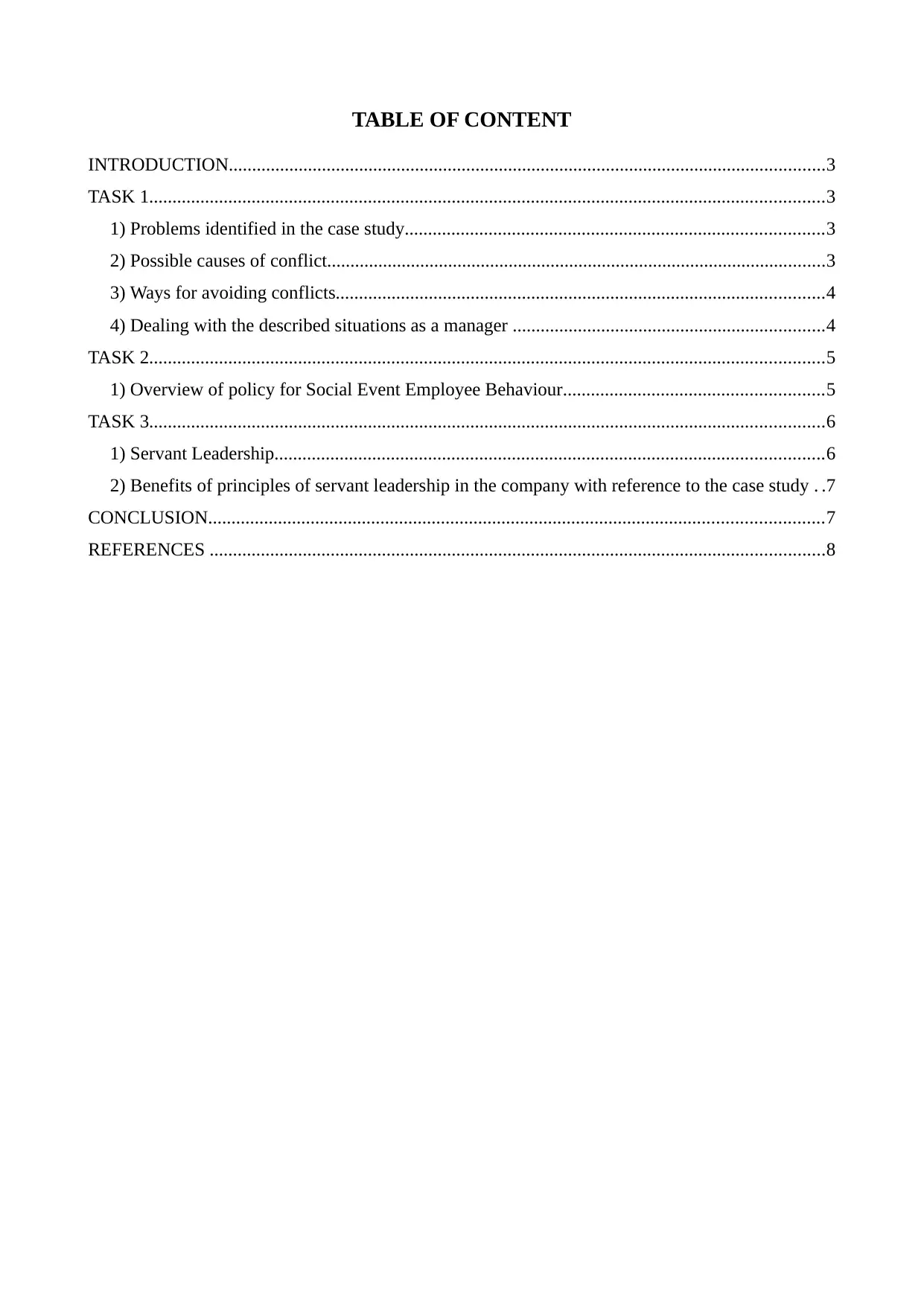
TABLE OF CONTENT
INTRODUCTION................................................................................................................................3
TASK 1.................................................................................................................................................3
1) Problems identified in the case study..........................................................................................3
2) Possible causes of conflict...........................................................................................................3
3) Ways for avoiding conflicts.........................................................................................................4
4) Dealing with the described situations as a manager ...................................................................4
TASK 2.................................................................................................................................................5
1) Overview of policy for Social Event Employee Behaviour........................................................5
TASK 3.................................................................................................................................................6
1) Servant Leadership......................................................................................................................6
2) Benefits of principles of servant leadership in the company with reference to the case study . .7
CONCLUSION....................................................................................................................................7
REFERENCES ....................................................................................................................................8
INTRODUCTION................................................................................................................................3
TASK 1.................................................................................................................................................3
1) Problems identified in the case study..........................................................................................3
2) Possible causes of conflict...........................................................................................................3
3) Ways for avoiding conflicts.........................................................................................................4
4) Dealing with the described situations as a manager ...................................................................4
TASK 2.................................................................................................................................................5
1) Overview of policy for Social Event Employee Behaviour........................................................5
TASK 3.................................................................................................................................................6
1) Servant Leadership......................................................................................................................6
2) Benefits of principles of servant leadership in the company with reference to the case study . .7
CONCLUSION....................................................................................................................................7
REFERENCES ....................................................................................................................................8
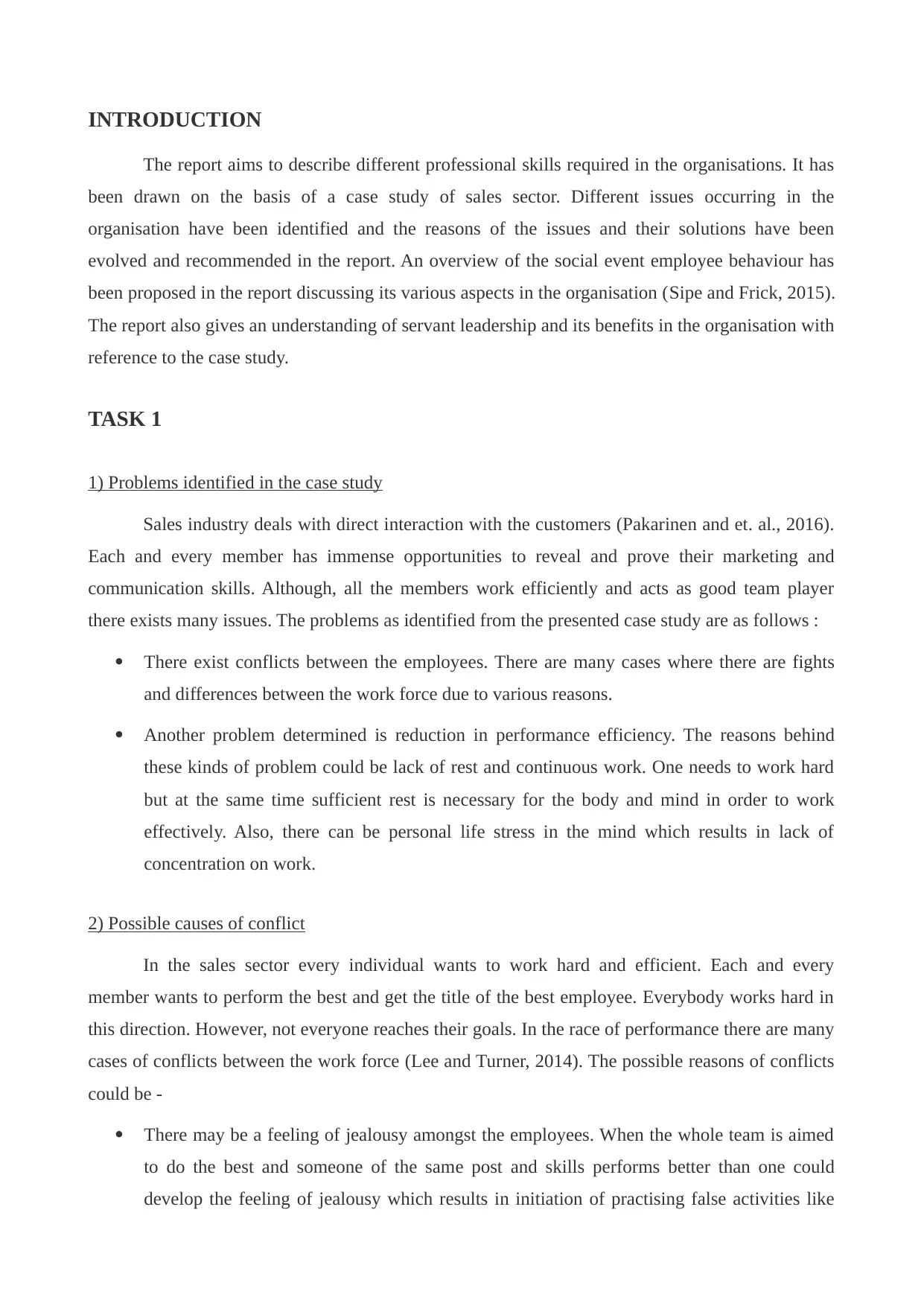
INTRODUCTION
The report aims to describe different professional skills required in the organisations. It has
been drawn on the basis of a case study of sales sector. Different issues occurring in the
organisation have been identified and the reasons of the issues and their solutions have been
evolved and recommended in the report. An overview of the social event employee behaviour has
been proposed in the report discussing its various aspects in the organisation (Sipe and Frick, 2015).
The report also gives an understanding of servant leadership and its benefits in the organisation with
reference to the case study.
TASK 1
1) Problems identified in the case study
Sales industry deals with direct interaction with the customers (Pakarinen and et. al., 2016).
Each and every member has immense opportunities to reveal and prove their marketing and
communication skills. Although, all the members work efficiently and acts as good team player
there exists many issues. The problems as identified from the presented case study are as follows :
There exist conflicts between the employees. There are many cases where there are fights
and differences between the work force due to various reasons.
Another problem determined is reduction in performance efficiency. The reasons behind
these kinds of problem could be lack of rest and continuous work. One needs to work hard
but at the same time sufficient rest is necessary for the body and mind in order to work
effectively. Also, there can be personal life stress in the mind which results in lack of
concentration on work.
2) Possible causes of conflict
In the sales sector every individual wants to work hard and efficient. Each and every
member wants to perform the best and get the title of the best employee. Everybody works hard in
this direction. However, not everyone reaches their goals. In the race of performance there are many
cases of conflicts between the work force (Lee and Turner, 2014). The possible reasons of conflicts
could be -
There may be a feeling of jealousy amongst the employees. When the whole team is aimed
to do the best and someone of the same post and skills performs better than one could
develop the feeling of jealousy which results in initiation of practising false activities like
The report aims to describe different professional skills required in the organisations. It has
been drawn on the basis of a case study of sales sector. Different issues occurring in the
organisation have been identified and the reasons of the issues and their solutions have been
evolved and recommended in the report. An overview of the social event employee behaviour has
been proposed in the report discussing its various aspects in the organisation (Sipe and Frick, 2015).
The report also gives an understanding of servant leadership and its benefits in the organisation with
reference to the case study.
TASK 1
1) Problems identified in the case study
Sales industry deals with direct interaction with the customers (Pakarinen and et. al., 2016).
Each and every member has immense opportunities to reveal and prove their marketing and
communication skills. Although, all the members work efficiently and acts as good team player
there exists many issues. The problems as identified from the presented case study are as follows :
There exist conflicts between the employees. There are many cases where there are fights
and differences between the work force due to various reasons.
Another problem determined is reduction in performance efficiency. The reasons behind
these kinds of problem could be lack of rest and continuous work. One needs to work hard
but at the same time sufficient rest is necessary for the body and mind in order to work
effectively. Also, there can be personal life stress in the mind which results in lack of
concentration on work.
2) Possible causes of conflict
In the sales sector every individual wants to work hard and efficient. Each and every
member wants to perform the best and get the title of the best employee. Everybody works hard in
this direction. However, not everyone reaches their goals. In the race of performance there are many
cases of conflicts between the work force (Lee and Turner, 2014). The possible reasons of conflicts
could be -
There may be a feeling of jealousy amongst the employees. When the whole team is aimed
to do the best and someone of the same post and skills performs better than one could
develop the feeling of jealousy which results in initiation of practising false activities like
⊘ This is a preview!⊘
Do you want full access?
Subscribe today to unlock all pages.

Trusted by 1+ million students worldwide
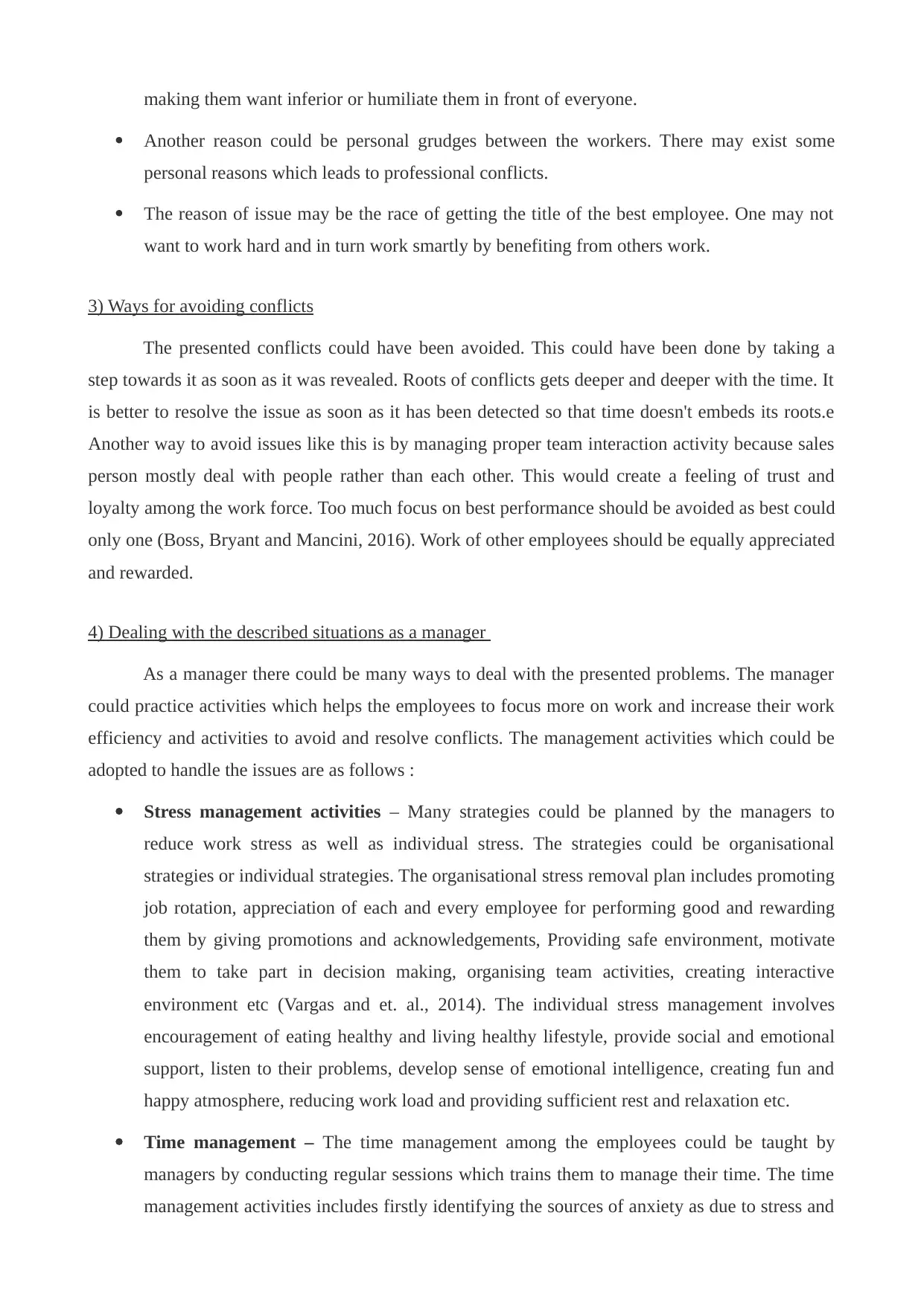
making them want inferior or humiliate them in front of everyone.
Another reason could be personal grudges between the workers. There may exist some
personal reasons which leads to professional conflicts.
The reason of issue may be the race of getting the title of the best employee. One may not
want to work hard and in turn work smartly by benefiting from others work.
3) Ways for avoiding conflicts
The presented conflicts could have been avoided. This could have been done by taking a
step towards it as soon as it was revealed. Roots of conflicts gets deeper and deeper with the time. It
is better to resolve the issue as soon as it has been detected so that time doesn't embeds its roots.e
Another way to avoid issues like this is by managing proper team interaction activity because sales
person mostly deal with people rather than each other. This would create a feeling of trust and
loyalty among the work force. Too much focus on best performance should be avoided as best could
only one (Boss, Bryant and Mancini, 2016). Work of other employees should be equally appreciated
and rewarded.
4) Dealing with the described situations as a manager
As a manager there could be many ways to deal with the presented problems. The manager
could practice activities which helps the employees to focus more on work and increase their work
efficiency and activities to avoid and resolve conflicts. The management activities which could be
adopted to handle the issues are as follows :
Stress management activities – Many strategies could be planned by the managers to
reduce work stress as well as individual stress. The strategies could be organisational
strategies or individual strategies. The organisational stress removal plan includes promoting
job rotation, appreciation of each and every employee for performing good and rewarding
them by giving promotions and acknowledgements, Providing safe environment, motivate
them to take part in decision making, organising team activities, creating interactive
environment etc (Vargas and et. al., 2014). The individual stress management involves
encouragement of eating healthy and living healthy lifestyle, provide social and emotional
support, listen to their problems, develop sense of emotional intelligence, creating fun and
happy atmosphere, reducing work load and providing sufficient rest and relaxation etc.
Time management – The time management among the employees could be taught by
managers by conducting regular sessions which trains them to manage their time. The time
management activities includes firstly identifying the sources of anxiety as due to stress and
Another reason could be personal grudges between the workers. There may exist some
personal reasons which leads to professional conflicts.
The reason of issue may be the race of getting the title of the best employee. One may not
want to work hard and in turn work smartly by benefiting from others work.
3) Ways for avoiding conflicts
The presented conflicts could have been avoided. This could have been done by taking a
step towards it as soon as it was revealed. Roots of conflicts gets deeper and deeper with the time. It
is better to resolve the issue as soon as it has been detected so that time doesn't embeds its roots.e
Another way to avoid issues like this is by managing proper team interaction activity because sales
person mostly deal with people rather than each other. This would create a feeling of trust and
loyalty among the work force. Too much focus on best performance should be avoided as best could
only one (Boss, Bryant and Mancini, 2016). Work of other employees should be equally appreciated
and rewarded.
4) Dealing with the described situations as a manager
As a manager there could be many ways to deal with the presented problems. The manager
could practice activities which helps the employees to focus more on work and increase their work
efficiency and activities to avoid and resolve conflicts. The management activities which could be
adopted to handle the issues are as follows :
Stress management activities – Many strategies could be planned by the managers to
reduce work stress as well as individual stress. The strategies could be organisational
strategies or individual strategies. The organisational stress removal plan includes promoting
job rotation, appreciation of each and every employee for performing good and rewarding
them by giving promotions and acknowledgements, Providing safe environment, motivate
them to take part in decision making, organising team activities, creating interactive
environment etc (Vargas and et. al., 2014). The individual stress management involves
encouragement of eating healthy and living healthy lifestyle, provide social and emotional
support, listen to their problems, develop sense of emotional intelligence, creating fun and
happy atmosphere, reducing work load and providing sufficient rest and relaxation etc.
Time management – The time management among the employees could be taught by
managers by conducting regular sessions which trains them to manage their time. The time
management activities includes firstly identifying the sources of anxiety as due to stress and
Paraphrase This Document
Need a fresh take? Get an instant paraphrase of this document with our AI Paraphraser
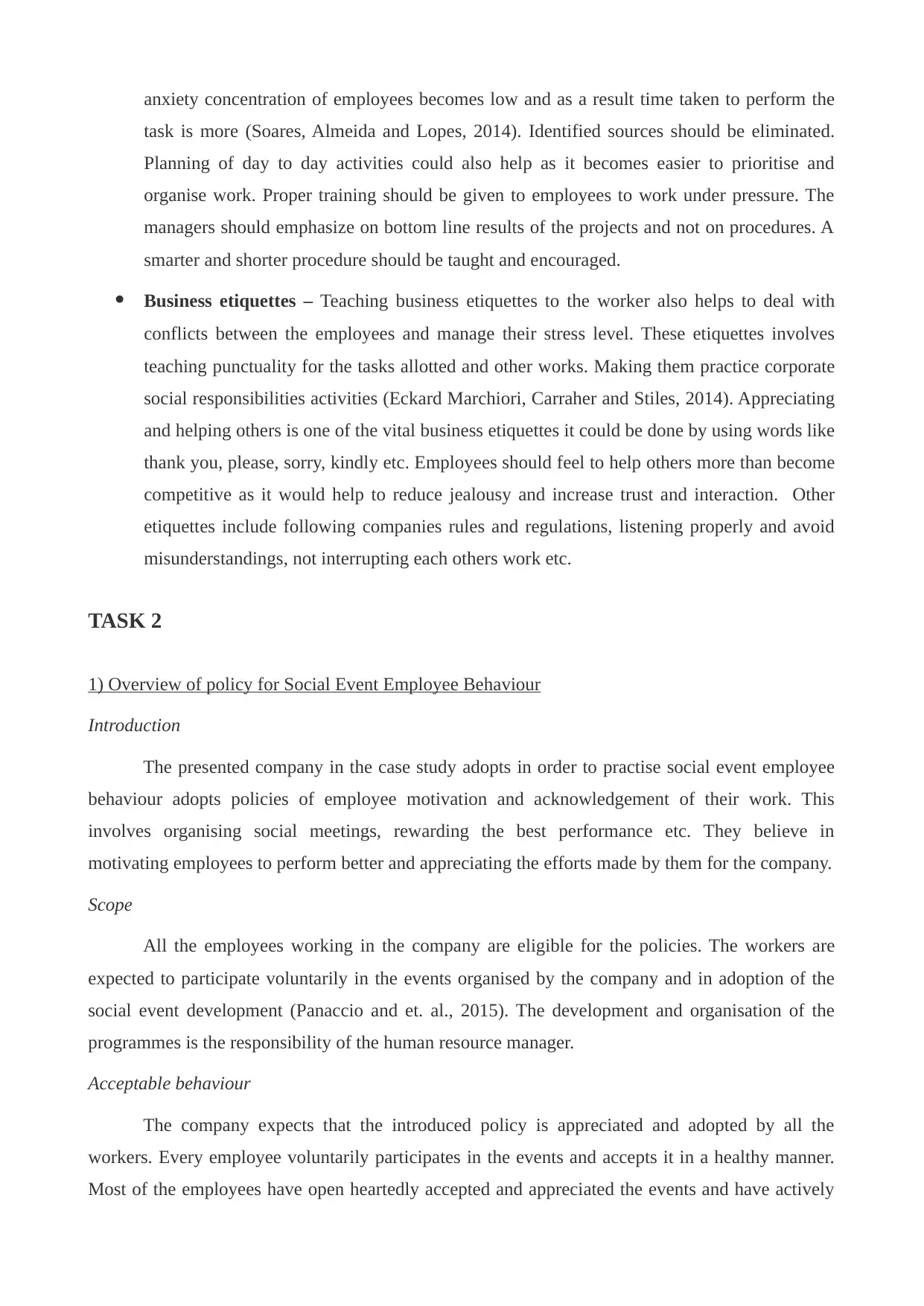
anxiety concentration of employees becomes low and as a result time taken to perform the
task is more (Soares, Almeida and Lopes, 2014). Identified sources should be eliminated.
Planning of day to day activities could also help as it becomes easier to prioritise and
organise work. Proper training should be given to employees to work under pressure. The
managers should emphasize on bottom line results of the projects and not on procedures. A
smarter and shorter procedure should be taught and encouraged.
Business etiquettes – Teaching business etiquettes to the worker also helps to deal with
conflicts between the employees and manage their stress level. These etiquettes involves
teaching punctuality for the tasks allotted and other works. Making them practice corporate
social responsibilities activities (Eckard Marchiori, Carraher and Stiles, 2014). Appreciating
and helping others is one of the vital business etiquettes it could be done by using words like
thank you, please, sorry, kindly etc. Employees should feel to help others more than become
competitive as it would help to reduce jealousy and increase trust and interaction. Other
etiquettes include following companies rules and regulations, listening properly and avoid
misunderstandings, not interrupting each others work etc.
TASK 2
1) Overview of policy for Social Event Employee Behaviour
Introduction
The presented company in the case study adopts in order to practise social event employee
behaviour adopts policies of employee motivation and acknowledgement of their work. This
involves organising social meetings, rewarding the best performance etc. They believe in
motivating employees to perform better and appreciating the efforts made by them for the company.
Scope
All the employees working in the company are eligible for the policies. The workers are
expected to participate voluntarily in the events organised by the company and in adoption of the
social event development (Panaccio and et. al., 2015). The development and organisation of the
programmes is the responsibility of the human resource manager.
Acceptable behaviour
The company expects that the introduced policy is appreciated and adopted by all the
workers. Every employee voluntarily participates in the events and accepts it in a healthy manner.
Most of the employees have open heartedly accepted and appreciated the events and have actively
task is more (Soares, Almeida and Lopes, 2014). Identified sources should be eliminated.
Planning of day to day activities could also help as it becomes easier to prioritise and
organise work. Proper training should be given to employees to work under pressure. The
managers should emphasize on bottom line results of the projects and not on procedures. A
smarter and shorter procedure should be taught and encouraged.
Business etiquettes – Teaching business etiquettes to the worker also helps to deal with
conflicts between the employees and manage their stress level. These etiquettes involves
teaching punctuality for the tasks allotted and other works. Making them practice corporate
social responsibilities activities (Eckard Marchiori, Carraher and Stiles, 2014). Appreciating
and helping others is one of the vital business etiquettes it could be done by using words like
thank you, please, sorry, kindly etc. Employees should feel to help others more than become
competitive as it would help to reduce jealousy and increase trust and interaction. Other
etiquettes include following companies rules and regulations, listening properly and avoid
misunderstandings, not interrupting each others work etc.
TASK 2
1) Overview of policy for Social Event Employee Behaviour
Introduction
The presented company in the case study adopts in order to practise social event employee
behaviour adopts policies of employee motivation and acknowledgement of their work. This
involves organising social meetings, rewarding the best performance etc. They believe in
motivating employees to perform better and appreciating the efforts made by them for the company.
Scope
All the employees working in the company are eligible for the policies. The workers are
expected to participate voluntarily in the events organised by the company and in adoption of the
social event development (Panaccio and et. al., 2015). The development and organisation of the
programmes is the responsibility of the human resource manager.
Acceptable behaviour
The company expects that the introduced policy is appreciated and adopted by all the
workers. Every employee voluntarily participates in the events and accepts it in a healthy manner.
Most of the employees have open heartedly accepted and appreciated the events and have actively
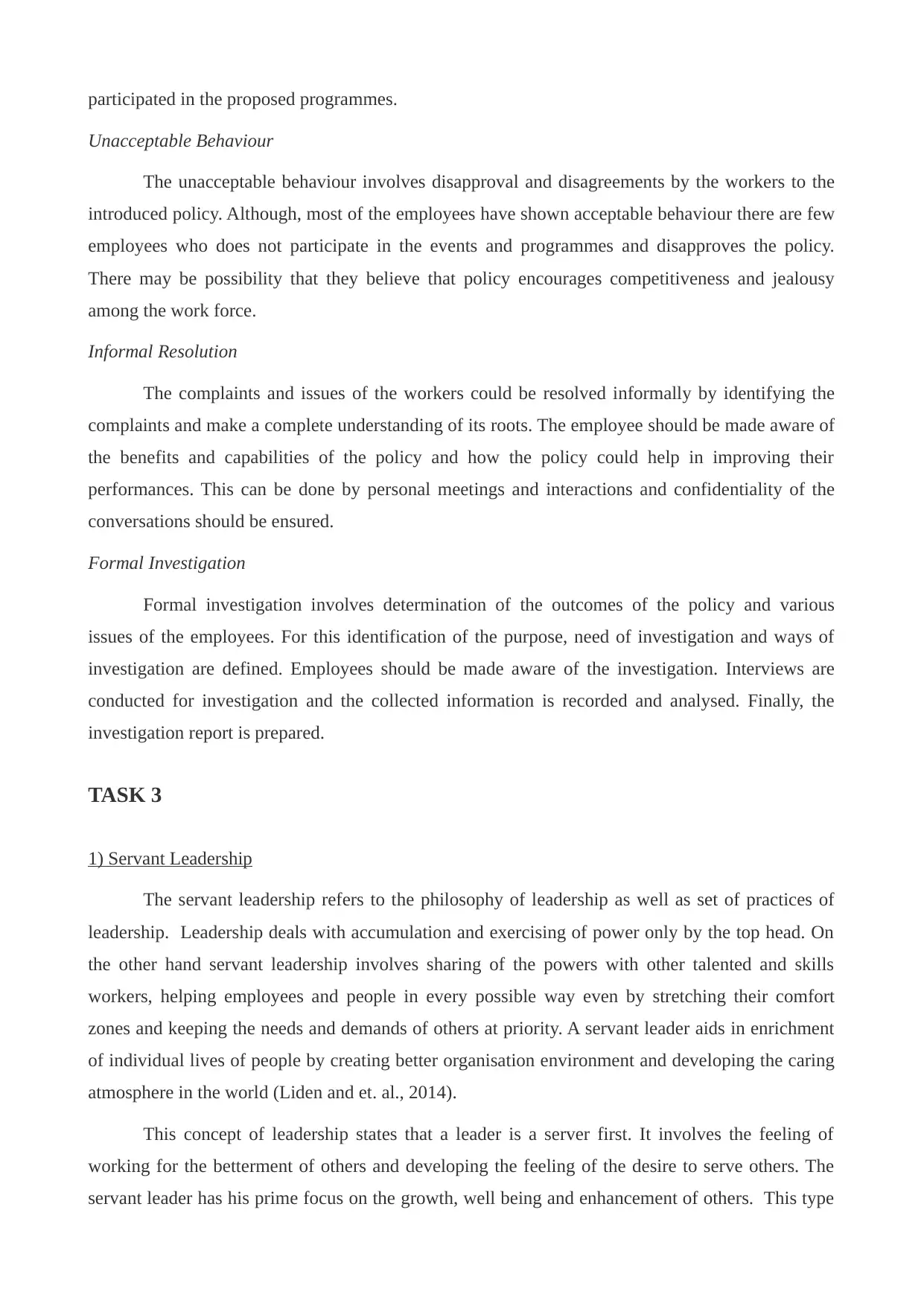
participated in the proposed programmes.
Unacceptable Behaviour
The unacceptable behaviour involves disapproval and disagreements by the workers to the
introduced policy. Although, most of the employees have shown acceptable behaviour there are few
employees who does not participate in the events and programmes and disapproves the policy.
There may be possibility that they believe that policy encourages competitiveness and jealousy
among the work force.
Informal Resolution
The complaints and issues of the workers could be resolved informally by identifying the
complaints and make a complete understanding of its roots. The employee should be made aware of
the benefits and capabilities of the policy and how the policy could help in improving their
performances. This can be done by personal meetings and interactions and confidentiality of the
conversations should be ensured.
Formal Investigation
Formal investigation involves determination of the outcomes of the policy and various
issues of the employees. For this identification of the purpose, need of investigation and ways of
investigation are defined. Employees should be made aware of the investigation. Interviews are
conducted for investigation and the collected information is recorded and analysed. Finally, the
investigation report is prepared.
TASK 3
1) Servant Leadership
The servant leadership refers to the philosophy of leadership as well as set of practices of
leadership. Leadership deals with accumulation and exercising of power only by the top head. On
the other hand servant leadership involves sharing of the powers with other talented and skills
workers, helping employees and people in every possible way even by stretching their comfort
zones and keeping the needs and demands of others at priority. A servant leader aids in enrichment
of individual lives of people by creating better organisation environment and developing the caring
atmosphere in the world (Liden and et. al., 2014).
This concept of leadership states that a leader is a server first. It involves the feeling of
working for the betterment of others and developing the feeling of the desire to serve others. The
servant leader has his prime focus on the growth, well being and enhancement of others. This type
Unacceptable Behaviour
The unacceptable behaviour involves disapproval and disagreements by the workers to the
introduced policy. Although, most of the employees have shown acceptable behaviour there are few
employees who does not participate in the events and programmes and disapproves the policy.
There may be possibility that they believe that policy encourages competitiveness and jealousy
among the work force.
Informal Resolution
The complaints and issues of the workers could be resolved informally by identifying the
complaints and make a complete understanding of its roots. The employee should be made aware of
the benefits and capabilities of the policy and how the policy could help in improving their
performances. This can be done by personal meetings and interactions and confidentiality of the
conversations should be ensured.
Formal Investigation
Formal investigation involves determination of the outcomes of the policy and various
issues of the employees. For this identification of the purpose, need of investigation and ways of
investigation are defined. Employees should be made aware of the investigation. Interviews are
conducted for investigation and the collected information is recorded and analysed. Finally, the
investigation report is prepared.
TASK 3
1) Servant Leadership
The servant leadership refers to the philosophy of leadership as well as set of practices of
leadership. Leadership deals with accumulation and exercising of power only by the top head. On
the other hand servant leadership involves sharing of the powers with other talented and skills
workers, helping employees and people in every possible way even by stretching their comfort
zones and keeping the needs and demands of others at priority. A servant leader aids in enrichment
of individual lives of people by creating better organisation environment and developing the caring
atmosphere in the world (Liden and et. al., 2014).
This concept of leadership states that a leader is a server first. It involves the feeling of
working for the betterment of others and developing the feeling of the desire to serve others. The
servant leader has his prime focus on the growth, well being and enhancement of others. This type
⊘ This is a preview!⊘
Do you want full access?
Subscribe today to unlock all pages.

Trusted by 1+ million students worldwide
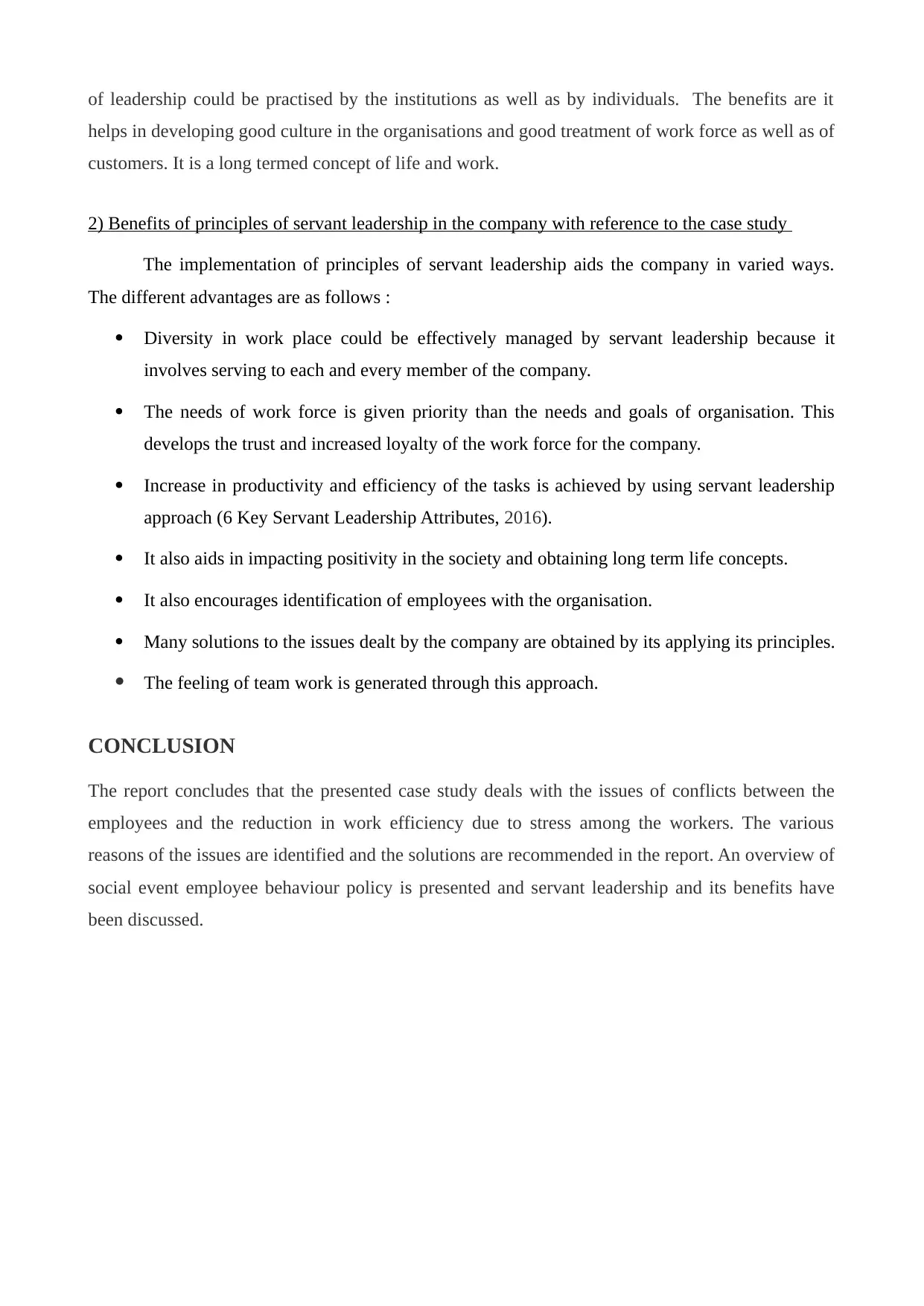
of leadership could be practised by the institutions as well as by individuals. The benefits are it
helps in developing good culture in the organisations and good treatment of work force as well as of
customers. It is a long termed concept of life and work.
2) Benefits of principles of servant leadership in the company with reference to the case study
The implementation of principles of servant leadership aids the company in varied ways.
The different advantages are as follows :
Diversity in work place could be effectively managed by servant leadership because it
involves serving to each and every member of the company.
The needs of work force is given priority than the needs and goals of organisation. This
develops the trust and increased loyalty of the work force for the company.
Increase in productivity and efficiency of the tasks is achieved by using servant leadership
approach (6 Key Servant Leadership Attributes, 2016).
It also aids in impacting positivity in the society and obtaining long term life concepts.
It also encourages identification of employees with the organisation.
Many solutions to the issues dealt by the company are obtained by its applying its principles.
The feeling of team work is generated through this approach.
CONCLUSION
The report concludes that the presented case study deals with the issues of conflicts between the
employees and the reduction in work efficiency due to stress among the workers. The various
reasons of the issues are identified and the solutions are recommended in the report. An overview of
social event employee behaviour policy is presented and servant leadership and its benefits have
been discussed.
helps in developing good culture in the organisations and good treatment of work force as well as of
customers. It is a long termed concept of life and work.
2) Benefits of principles of servant leadership in the company with reference to the case study
The implementation of principles of servant leadership aids the company in varied ways.
The different advantages are as follows :
Diversity in work place could be effectively managed by servant leadership because it
involves serving to each and every member of the company.
The needs of work force is given priority than the needs and goals of organisation. This
develops the trust and increased loyalty of the work force for the company.
Increase in productivity and efficiency of the tasks is achieved by using servant leadership
approach (6 Key Servant Leadership Attributes, 2016).
It also aids in impacting positivity in the society and obtaining long term life concepts.
It also encourages identification of employees with the organisation.
Many solutions to the issues dealt by the company are obtained by its applying its principles.
The feeling of team work is generated through this approach.
CONCLUSION
The report concludes that the presented case study deals with the issues of conflicts between the
employees and the reduction in work efficiency due to stress among the workers. The various
reasons of the issues are identified and the solutions are recommended in the report. An overview of
social event employee behaviour policy is presented and servant leadership and its benefits have
been discussed.
Paraphrase This Document
Need a fresh take? Get an instant paraphrase of this document with our AI Paraphraser
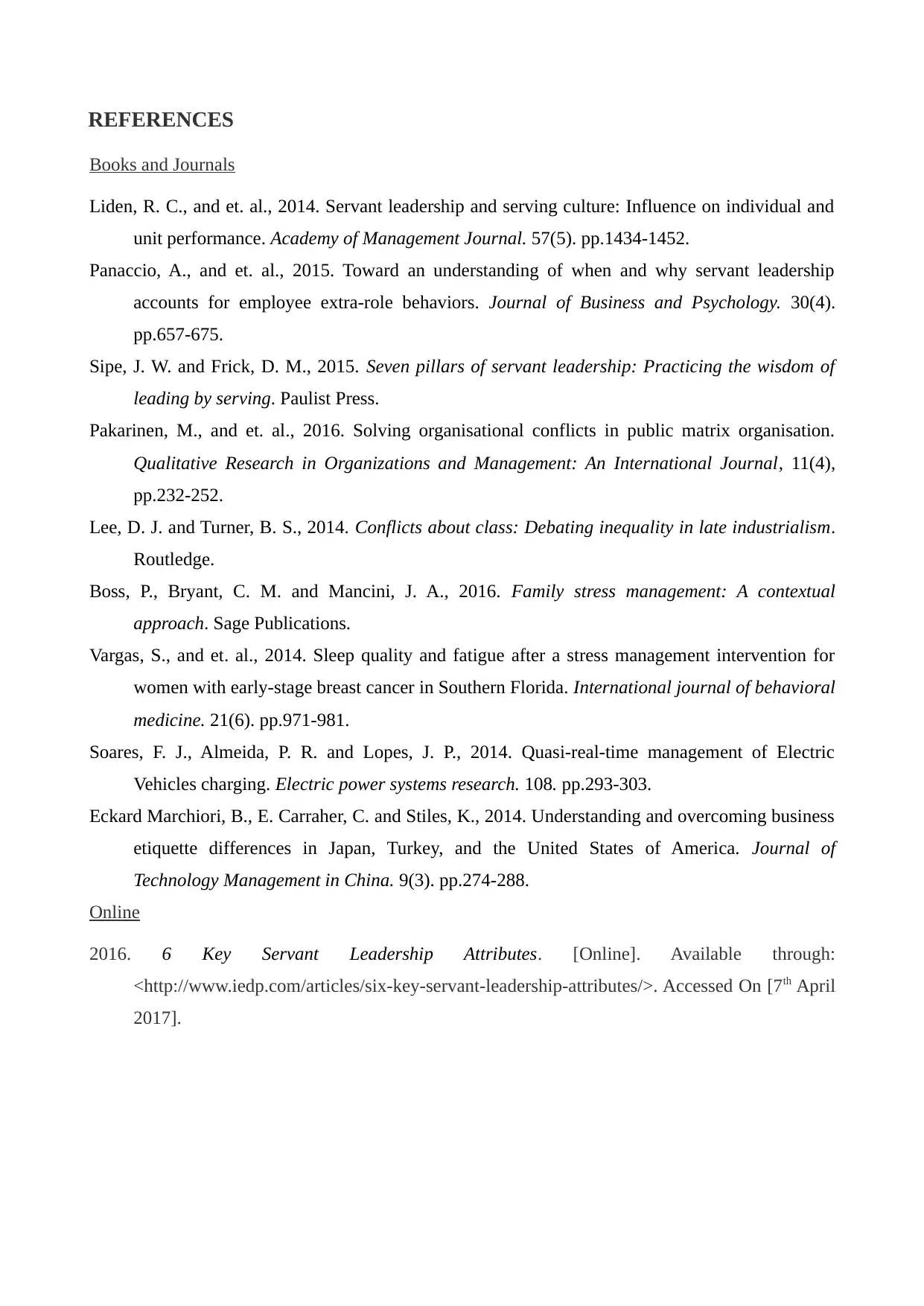
REFERENCES
Books and Journals
Liden, R. C., and et. al., 2014. Servant leadership and serving culture: Influence on individual and
unit performance. Academy of Management Journal. 57(5). pp.1434-1452.
Panaccio, A., and et. al., 2015. Toward an understanding of when and why servant leadership
accounts for employee extra-role behaviors. Journal of Business and Psychology. 30(4).
pp.657-675.
Sipe, J. W. and Frick, D. M., 2015. Seven pillars of servant leadership: Practicing the wisdom of
leading by serving. Paulist Press.
Pakarinen, M., and et. al., 2016. Solving organisational conflicts in public matrix organisation.
Qualitative Research in Organizations and Management: An International Journal, 11(4),
pp.232-252.
Lee, D. J. and Turner, B. S., 2014. Conflicts about class: Debating inequality in late industrialism.
Routledge.
Boss, P., Bryant, C. M. and Mancini, J. A., 2016. Family stress management: A contextual
approach. Sage Publications.
Vargas, S., and et. al., 2014. Sleep quality and fatigue after a stress management intervention for
women with early-stage breast cancer in Southern Florida. International journal of behavioral
medicine. 21(6). pp.971-981.
Soares, F. J., Almeida, P. R. and Lopes, J. P., 2014. Quasi-real-time management of Electric
Vehicles charging. Electric power systems research. 108. pp.293-303.
Eckard Marchiori, B., E. Carraher, C. and Stiles, K., 2014. Understanding and overcoming business
etiquette differences in Japan, Turkey, and the United States of America. Journal of
Technology Management in China. 9(3). pp.274-288.
Online
2016. 6 Key Servant Leadership Attributes. [Online]. Available through:
<http://www.iedp.com/articles/six-key-servant-leadership-attributes/>. Accessed On [7th April
2017].
Books and Journals
Liden, R. C., and et. al., 2014. Servant leadership and serving culture: Influence on individual and
unit performance. Academy of Management Journal. 57(5). pp.1434-1452.
Panaccio, A., and et. al., 2015. Toward an understanding of when and why servant leadership
accounts for employee extra-role behaviors. Journal of Business and Psychology. 30(4).
pp.657-675.
Sipe, J. W. and Frick, D. M., 2015. Seven pillars of servant leadership: Practicing the wisdom of
leading by serving. Paulist Press.
Pakarinen, M., and et. al., 2016. Solving organisational conflicts in public matrix organisation.
Qualitative Research in Organizations and Management: An International Journal, 11(4),
pp.232-252.
Lee, D. J. and Turner, B. S., 2014. Conflicts about class: Debating inequality in late industrialism.
Routledge.
Boss, P., Bryant, C. M. and Mancini, J. A., 2016. Family stress management: A contextual
approach. Sage Publications.
Vargas, S., and et. al., 2014. Sleep quality and fatigue after a stress management intervention for
women with early-stage breast cancer in Southern Florida. International journal of behavioral
medicine. 21(6). pp.971-981.
Soares, F. J., Almeida, P. R. and Lopes, J. P., 2014. Quasi-real-time management of Electric
Vehicles charging. Electric power systems research. 108. pp.293-303.
Eckard Marchiori, B., E. Carraher, C. and Stiles, K., 2014. Understanding and overcoming business
etiquette differences in Japan, Turkey, and the United States of America. Journal of
Technology Management in China. 9(3). pp.274-288.
Online
2016. 6 Key Servant Leadership Attributes. [Online]. Available through:
<http://www.iedp.com/articles/six-key-servant-leadership-attributes/>. Accessed On [7th April
2017].

⊘ This is a preview!⊘
Do you want full access?
Subscribe today to unlock all pages.

Trusted by 1+ million students worldwide
1 out of 9
Related Documents
Your All-in-One AI-Powered Toolkit for Academic Success.
+13062052269
info@desklib.com
Available 24*7 on WhatsApp / Email
![[object Object]](/_next/static/media/star-bottom.7253800d.svg)
Unlock your academic potential
Copyright © 2020–2025 A2Z Services. All Rights Reserved. Developed and managed by ZUCOL.





